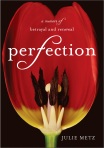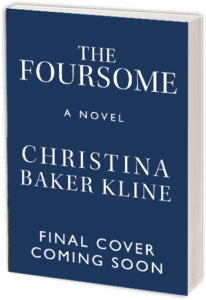The inside scoop on what makes a successful book cover – and why it matters.
Several weeks ago I wrote about the jacket cover for my new novel, Bird in Hand. So many people responded with stories about their own covers, and questions about the process, that I asked Julie Metz, a book designer who has worked with all the major publishers (and who also recently wrote a memoir, Perfection) to weigh in. We talked about how she designs covers, what kinds of covers are most successful, and what writers should know about how to get the covers they want. (Part 2 of this conversation will run later this week.)
Thanks for joining us, Julie. How do you approach the process of designing a book cover? First I try to get hold of a manuscript. If this isn’t possible I settle for a tip sheet or an outline. Editors often provide useful information such as competitive titles in the marketplace, and occasionally I’ll be sent an author questionnaire. I try to factor in all these influences before I begin, then take a deep breath. Every project is a journey.
 I read a piece the other day about how the cover for Tom Perrotta’s novel Little Children spawned a dozen or so similar ones. As a designer, do you consciously try to avoid colors, motifs, or trends that seem popular in a given moment, or do you embrace them? Trends are out there in the world, like the latest styles of shoes or jeans, so as a visual person you take them in whether you realize it or not. Sometimes I embrace the trends, or am asked to embrace them, or rebel and reject them. A book cover is essentially packaging, and as we all know, packaging is more important than ever. It’s important to find a way to signal to the book buyer where this new title fits in, or, if it is truly original, that it doesn’t fit into any neat category.
I read a piece the other day about how the cover for Tom Perrotta’s novel Little Children spawned a dozen or so similar ones. As a designer, do you consciously try to avoid colors, motifs, or trends that seem popular in a given moment, or do you embrace them? Trends are out there in the world, like the latest styles of shoes or jeans, so as a visual person you take them in whether you realize it or not. Sometimes I embrace the trends, or am asked to embrace them, or rebel and reject them. A book cover is essentially packaging, and as we all know, packaging is more important than ever. It’s important to find a way to signal to the book buyer where this new title fits in, or, if it is truly original, that it doesn’t fit into any neat category.
What are some of your own most meaningful cover designs, and why? A good cover is a smart, clever idea executed in a way that is eye-catching. It’s all about helping authors find readers – serving the content of the book in a way that will help a browser want to pick it up. You wouldn’t want to package the latest thriller the same way as this year’s big literary novel. I have enjoyed working on spooky vampire gothic novels as much as I have enjoyed designing the cover for a terrific novel or poetry collection.
Here are a few examples, and the stories behind them:
 The Dracula Dossier is a fun read, and the cover was fun to design. The challenge was putting together pieces from several images to make it all look like one universe. The story takes place in London during the time of Jack the Ripper, and the theater plays a big part in the story. I think the curtain adds mystery and some information for the reader about the setting.
The Dracula Dossier is a fun read, and the cover was fun to design. The challenge was putting together pieces from several images to make it all look like one universe. The story takes place in London during the time of Jack the Ripper, and the theater plays a big part in the story. I think the curtain adds mystery and some information for the reader about the setting.
 The poems in Charlie Smith’s Word Comix are engaging and full of fantastic imagery, and I wanted to treat the cover as if the book were a novel. The author suggested the Western element, and when I found this picture I knew my work was done. I added some elements to give it a more gravity-defying feel. I love doing hand-lettering whenever I can get away with it.
The poems in Charlie Smith’s Word Comix are engaging and full of fantastic imagery, and I wanted to treat the cover as if the book were a novel. The author suggested the Western element, and when I found this picture I knew my work was done. I added some elements to give it a more gravity-defying feel. I love doing hand-lettering whenever I can get away with it.
 We designers live for the AIGA “50 covers 50 books” show, and I am proud that this Ezra Pound cover won a spot in the show. As I mentioned, I love doing hand-lettering – and it seemed so appropriate for this collection of correspondence. I tried to give it an edgy, desperate feeling.
We designers live for the AIGA “50 covers 50 books” show, and I am proud that this Ezra Pound cover won a spot in the show. As I mentioned, I love doing hand-lettering – and it seemed so appropriate for this collection of correspondence. I tried to give it an edgy, desperate feeling.
 I hired a picture researcher to help me with the cover for Inheritance. She had a friend whose mother had grown up in China at the right time, and there were family photos. We did some hand-coloring, and I tried to channel my inner calligrapher.
I hired a picture researcher to help me with the cover for Inheritance. She had a friend whose mother had grown up in China at the right time, and there were family photos. We did some hand-coloring, and I tried to channel my inner calligrapher.
 The title of Barbara Gowdy’s novel The Romantic is somewhat ironic, so I wanted to find an image that showed the edgier, sharper side of love.
The title of Barbara Gowdy’s novel The Romantic is somewhat ironic, so I wanted to find an image that showed the edgier, sharper side of love.
What’s your most “successful” cover?  A book cover I wish I had been paid royalties for, because it has withstood the test of time: The Poisonwood Bible by Barbara Kingsolver. When the art director assigned the job, he said that the mission was to take the author out of what might be called “genre” fiction to something wider. I read the book and loved it. I purchased Bible paper and organized a photo shoot to create the book for the background. I chose elegant, classic type, as we all saw this novel as a modern classic. But the cover was still missing something. At 2 am (this was long before I had a baby, and my freelancer hours were night-owlish), I was fretting over the design in progress. My then-husband said he felt it needed a human element.
A book cover I wish I had been paid royalties for, because it has withstood the test of time: The Poisonwood Bible by Barbara Kingsolver. When the art director assigned the job, he said that the mission was to take the author out of what might be called “genre” fiction to something wider. I read the book and loved it. I purchased Bible paper and organized a photo shoot to create the book for the background. I chose elegant, classic type, as we all saw this novel as a modern classic. But the cover was still missing something. At 2 am (this was long before I had a baby, and my freelancer hours were night-owlish), I was fretting over the design in progress. My then-husband said he felt it needed a human element.
I began thinking about the story, about how these five hapless Americans in the missionary family that narrate the novel might be seen by the indigenous people of the Congo, where the story takes place. I found a great book on art of the Congo and noted that they created wonderful drawings using stick figures that, even in their simplicity, revealed so much about character. Inspired by this artwork, I created five stick figures of my own. My art director, Joseph Montebello, loved the design and fought hard to get it approved. I think the cover really did help the book succeed. It’s a great book and would have been successful anyway, but I like to think that the successful packaging made a difference.
 Was it harder or easier than usual to design your own book cover?It was harder! I felt like I had so much on the line. I wrote a piece about this for the May 25, 2009 edition of Publishers Weekly titled “Double Duty,” a title that accurately sums up the emotions I experienced as I worked on the cover.
Was it harder or easier than usual to design your own book cover?It was harder! I felt like I had so much on the line. I wrote a piece about this for the May 25, 2009 edition of Publishers Weekly titled “Double Duty,” a title that accurately sums up the emotions I experienced as I worked on the cover.
